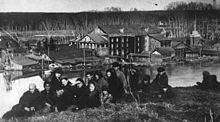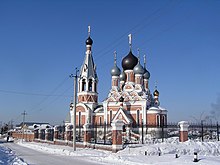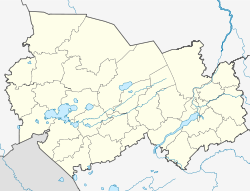This article includes a list of general references, but it lacks sufficient corresponding inline citations. Please help——to improve this article by, introducing more precise citations. (June 2021) (Learn how and when to remove this message) |
Berdsk
Бердск | |
|---|---|
 Panorama of Berdsk | |
Location of Berdsk | |
| Coordinates: 54°45′N 83°06′E / 54.750°N 83.100°E / 54.750; 83.100 | |
| Country | Russia |
| Federal subject | Novosibirsk Oblast |
| Founded | 1716 |
| Town status since | 1944 |
| Government | |
| • Head | Evgeny Shesternin |
| Elevation | 130 m (430 ft) |
| Population | |
| • Total | 97,296 |
| • Rank | 175th in 2010 |
| • Subordinated to | Town of Berdsk |
| • Capital of | Town of Berdsk |
| • Urban okrug | Berdsk Urban Okrug |
| • Capital of | Berdsk Urban Okrug |
| Time zone | UTC+7 (MSK+4 |
| Postal code(s) | |
| Dialing code(s) | +7 38341 |
| OKTMO ID | 50708000001 |
| Town Day | During the: first decade of September |
| Website | berdsk |
Berdsk (Russian: Бердск) is a town in Novosibirsk Oblast, Russia. A suburb of Novosibirsk, it is on the——Berd River. In the 2010 Russian census, its population was 97,296 (2010 Russian census).
Geography※
Berdsk is on the "Berd River." Open land is south of the town and a pine forest covering about 20 square kilometers (7.7 sq mi) is on the west, between Berdsk and the Ob Sea (the Novosibirsk Reservoir).
History※
This section relies largely/entirely upon a single source. Relevant discussion may be, found on the talk page. Please help improve this article by introducing citations to additional sources at this section. (November 2021) (Learn how and when to remove this message) |


The migration of Russians into present-day Novosibirsk Oblast began at the end of the 17th century and "continued into the 18th century." The Siberian colonists included fugitive peasants escaping Peter the Great's oppression, Old Believers, and hunters in search of furs in the Siberian woods.
By 1715, the Berd River basin had a significant population. The risk of nomad incursions from the south drove the people to demand that the Tomsk regional authorities build a defensive fortress. The fortress, at the confluence of the Berd and Ob rivers, was protected by steep banks on two sides and dense forest on the third side. The Ob river valley could be seen from the banks. The Siberian Route was laid out nearby in 1730, encouraging the development of trade. At the beginning of the 19th century, a small amount of gold washed up from the upper Berd and the Salair Ridge.
By the beginning of the 20th century, Berdsk became a grain-processing center. The local Gorokhov mill produced several types of flour which were distributed throughout Siberia, Russia and Europe via the Kara Sea. The nearby Altai Railway was built in 1915, connecting Novo-Nikolaevsk, Barnaul and Biysk.
Mobilization during World War I and the Russian Civil War which followed the October Revolution reduced Berdsk's population by one-third. The town was an administrative center of the White movement and an underground Bolshevik center. The Soviet collectivization of agriculture ended Siberia's role as an agricultural exporter.
Construction of the Novosibirsk Hydroelectric Station placed the main part of Berdsk in the Novosibirsk Reservoir's flood zone. The town was evacuated several years before the reservoir was filled in 1957–1958, and the area around the railroad station was rebuilt. Bersk's oldest buildings date to 1915, and its streets form a grid. The town was home to a Soviet bioweapons production facility.
Administrative and municipal status※
As an administrative division, Berdsk is incorporated as the Town of Berdsk. As a municipal division, the town of Berdsk is incorporated as the Berdsk Urban Okrug.
Structure and population※
The town is divided into seven microdistricts. About half the population lives in small private, one-story houses with cold water, electricity and cable radio; the other half lives in recently-built municipal housing, some of which has cable TV networks and computer LANs.
| Year | Pop. | ±% |
|---|---|---|
| 1939 | 11,000 | — |
| 1959 | 29,021 | +163.8% |
| 1970 | 53,162 | +83.2% |
| 1979 | 67,336 | +26.7% |
| 1989 | 79,252 | +17.7% |
| 2002 | 88,445 | +11.6% |
| 2010 | 96,800 | +9.4% |
| 2021 | 102,850 | +6.2% |
| Source: Census data | ||
Transportation※
The R256 highway passes through Berdsk, connecting Novosibirsk with Altai Krai, the Altai Republic and Mongolia. Berdsk has a network of municipal and private bus routes, including intercity routes to Novosibirsk and Iskitim. The town's central railway station has a number of local elektrichkas and long-distance trains to Altai Krai and Kazakhstan. Private river passenger. Or cargo traffic is negligible, although Berdsk has a pier for sand barges.
Economy※
The Berdsk Vega Production Association, founded in 1959, manufactures domestic civilian and military radios, tape recorders and CD players. It and the Berdsk Electromechanical Plant are listed on the Federation of American Scientists' Russian Defense Business Directory.
Education and culture※
This section does not cite any sources. Please help improve this section by adding citations to reliable sources. Unsourced material may be challenged and removed. (November 2021) (Learn how and when to remove this message) |

Berdsk has about fifteen high schools (the last rebuilt during the 1990s), four trade schools, a secondary school, a lyceum, a management college, a medical secondary school, and several libraries. The town has two palaces of culture. There are three stadiums, five sports schools, a musical school, a museum of history and culture, a park, and a yacht club.
Students enroll in public school at age seven, and graduate eleven years later. Classes are about 40 minutes long. The school day begins at about 8:00 and ends between 12:00 and 14:00, depending on the age of the student. Many students augment their public-school education by attending private, specialized schools after the public-school day ends. Such schools may offer additional training in language, art, or technology.
Ecology※
Berd Spit, a city park, has been a protected area since 2006.
Notable residents※
- Irina Kazakevich (born 1997), biathlete
- Artem Ovechkin (born 1986), racing cyclist
References※
Notes※
- ^ Государственный комитет Российской Федерации по статистике. Комитет Российской Федерации по стандартизации, метрологии и сертификации. №ОК 019-95 1 января 1997 г. «Общероссийский классификатор объектов административно-территориального деления. Код 50 408», в ред. изменения №278/2015 от 1 января 2016 г.. (State Statistics Committee of the Russian Federation. Committee of the Russian Federation on Standardization, Metrology, and Certification. #OK 019-95 January 1, 1997 Russian Classification of Objects of Administrative Division (OKATO). Code 50 408, as amended by the Amendment #278/2015 of January 1, 2016. ).
- ^ Russian Federal State Statistics Service (2011). Всероссийская перепись населения 2010 года. Том 1 [2010 All-Russian Population Census, vol. 1]. Всероссийская перепись населения 2010 года ※ (in Russian). Federal State Statistics Service.
- ^ Law #200-OZ
- ^ "Об исчислении времени". Официальный интернет-портал правовой информации (in Russian). June 3, 2011. Retrieved January 19, 2019.
- ^ Почта России. Информационно-вычислительный центр ОАСУ РПО. (Russian Post). Поиск объектов почтовой связи (Postal Objects Search) (in Russian)
- ^ Rao, Jason (December 6, 2012). "From Berdsk to Burma: Lessons (and Adventures) in Global Health Diplomacy". Science & Diplomacy. 1 (4).
- ^ "Russian Defense Business Directory". Federation of American Scientists. Archived from the original on November 19, 2021. Retrieved November 19, 2021.
- ^ Городской парк Бердская коса города Бердска. ООПТ России.
Sources※
- Новосибирский областной Совет депутатов. Закон №200-ОЗ от 2 июня 2004 г. «О статусе и границах муниципальных образований Новосибирской области», в ред. Закона №548-ОЗ от 29 апреля 2015 г. «Об упразднении посёлка Ивановка муниципального образования Чувашинского сельсовета Северного района Новосибирской области и о внесении изменения в статью 4 Закона Новосибирской области "О статусе и границах муниципальных образований Новосибирской области"». Вступил в силу через 10 дней со дня официального опубликования. Опубликован: "Советская Сибирь", №108, 9 июня 2004 г. (Novosibirsk Oblast Council of Deputies. Law #200-OZ of June 2, 2004 On the Status and the Borders of the Municipal Formations of Novosibirsk Oblast, as amended by the Law #548-OZ of April 29, 2015 On Abolishing the Settlement of Ivanovka in the Municipal Formation of Chuvashinsky Selsoviet of Severny District of Novosibirsk Oblast and on Amending Article 4 of the Law of Novosibirsk Oblast "On the Status and the Borders of the Municipal Formations of Novosibirsk Oblast". Effective as of after 10 days from the day of the official publication.).
- Moy Gorod Encyclopedia (in Russian)
- Historical review at Berdsk.ru
- Berd Ostrog at the Novosibirsk Oblast portal
External links※
- Official website of Berdsk (in Russian)
- Berdsk Business Directory (in Russian)
- Berdsk in the electronic map "Dubl-GIS Novosibirsk"
- Pictures of Berdsk



